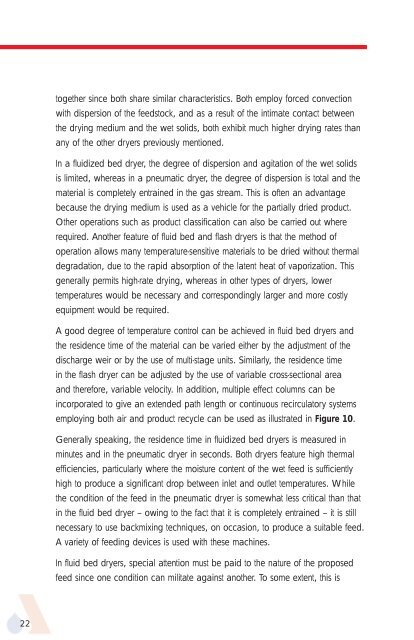APV Dryer Handbook - Umbc
APV Dryer Handbook - Umbc
APV Dryer Handbook - Umbc
Create successful ePaper yourself
Turn your PDF publications into a flip-book with our unique Google optimized e-Paper software.
22<br />
together since both share similar characteristics. Both employ forced convection<br />
with dispersion of the feedstock, and as a result of the intimate contact between<br />
the drying medium and the wet solids, both exhibit much higher drying rates than<br />
any of the other dryers previously mentioned.<br />
In a fluidized bed dryer, the degree of dispersion and agitation of the wet solids<br />
is limited, whereas in a pneumatic dryer, the degree of dispersion is total and the<br />
material is completely entrained in the gas stream. This is often an advantage<br />
because the drying medium is used as a vehicle for the partially dried product.<br />
Other operations such as product classification can also be carried out where<br />
required. Another feature of fluid bed and flash dryers is that the method of<br />
operation allows many temperature-sensitive materials to be dried without thermal<br />
degradation, due to the rapid absorption of the latent heat of vaporization. This<br />
generally permits high-rate drying, whereas in other types of dryers, lower<br />
temperatures would be necessary and correspondingly larger and more costly<br />
equipment would be required.<br />
A good degree of temperature control can be achieved in fluid bed dryers and<br />
the residence time of the material can be varied either by the adjustment of the<br />
discharge weir or by the use of multi-stage units. Similarly, the residence time<br />
in the flash dryer can be adjusted by the use of variable cross-sectional area<br />
and therefore, variable velocity. In addition, multiple effect columns can be<br />
incorporated to give an extended path length or continuous recirculatory systems<br />
employing both air and product recycle can be used as illustrated in Figure 10.<br />
Generally speaking, the residence time in fluidized bed dryers is measured in<br />
minutes and in the pneumatic dryer in seconds. Both dryers feature high thermal<br />
efficiencies, particularly where the moisture content of the wet feed is sufficiently<br />
high to produce a significant drop between inlet and outlet temperatures. While<br />
the condition of the feed in the pneumatic dryer is somewhat less critical than that<br />
in the fluid bed dryer – owing to the fact that it is completely entrained – it is still<br />
necessary to use backmixing techniques, on occasion, to produce a suitable feed.<br />
A variety of feeding devices is used with these machines.<br />
In fluid bed dryers, special attention must be paid to the nature of the proposed<br />
feed since one condition can militate against another. To some extent, this is











